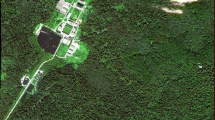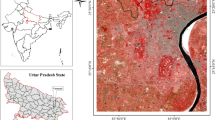Abstract
Most existing classification studies use spectral information and those were adequate for cities or plains. This paper explores classification method suitable for the ALOS (Advanced Land Observing Satellite) in mountainous terrain. Mountainous terrain mapping using ALOS image faces numerous challenges. These include spectral confusion with other land cover features, topographic effects on spectral signatures (such as shadow). At first, topographic radiometric correction was carried out to remove the illumination effects of topography. In addition to spectral features, texture features were used to assist classification in this paper. And texture features extracted based on GLCM (Gray Level Co-occurrence Matrix) were not only used for segmentation, but also used for building rules. The performance of the method was evaluated and compared with Maximum Likelihood Classification (MLC). Results showed that the object-oriented method integrating spectral and texture features has achieved overall accuracy of 85.73% with a kappa coefficient of 0.824, which is 13.48% and 0.145 respectively higher than that got by MLC method. It indicated that texture features can significantly improve overall accuracy, kappa coefficient, and the classification precision of existing spectrum confusion features. Object-oriented method Integrating spectral and texture features is suitable for land use extraction of ALOS image in mountainous terrain.
Similar content being viewed by others
References
Aplin P (2006) On scales and dynamics in observing the environment, International Journal of Remote Sensing 27(11): 2123–2140.
Baatz M, Schäpe A (2000) Multiresolution Segmentation: An Optimization Approach for High Quality Multi-scale Image Segmentation. In: Strobl J et al. (eds.), Angewandte geographische informationsverarbeitung XII, Heidelberg, Germany. pp 12–23.
Baraldi A, Parmiggiani F (1995) An investigation of the textual characteristics associated with gray level coocurrence matrix statistical parameters. IEEE Transactions on Geoscience and Remote Sensing 33(2): 293–304.
Chen CC, Huang CL (1993) Markov random fields for texture classification. Pattern Recognition Letters 14(11): 907–914.
Coburna CA, Robertsb ACB (2004) A multiscale texture analysis procedure for improved forest stand classification. International Journal of Remote Sensing 25(20): 4287–4308.
Congalton RG (1991) A review of assessing the accuracy of classifications of remotely sensed data. Remote Sensing of Environment 37(1): 35–46.
Dorren LKA, Maier B, Seijmonsbergen AC (2003) Improved Landsat-based forest mapping in steep mountainous terrain using object-based classification. Forest Ecology and Management 183(1): 31–46.
Drǎguť L, Tiede D, Levick SR (2010) ESP: a tool to estimate scale parameter for multiresolution image segmentation of remotely sensed data. International Journal of Geographical Information Science 24(6): 859–871.
Guindon B, Zhang Y, Dillabaugh C (2004) Landsat urban mapping based on a combined spectral-spatial methodology. Remote Sensing of Environment 92(2): 218–232.
Han N, Wang K, Yu L, Zhang XY (2012) Integration of texture and landscape features into object-based classification for delineating Torreya using IKONOS imagery. International Journal of Remote Sensing 33(7): 2003–2033.
Haralick RM, Shanmugam K (1973) Textural features for image classification. IEEE Transactions on Systems Man and Cybernetics 3(6): 610–621.
Hawkins JK (1969) Textural properties for pattern recognition. In: B. Lipkin and A. Rosenfeld (eds.), Picture Processing and Psychop ictorics. Academic Press, New York, USA. pp. 3472–3701.
Jensen JR (2007) Introductory Digital Image Processing (3rd Edition, Chinese version). Beijing: Science Press, China. pp. 378–390.
Jin, HR, Li PJ, Cheng T, et al. (2012) Land cover classification using CHRIS/PROBA images and multi-temporal texture. International Journal of Remote Sensing 33(1): 101–119.
Kabir S, He DC, Sanusi MA, et al. (2010) Texture analysis of IKONOS satellite imagery for urban land use and land cover classification. The imaging Science Journal 58(3): 163–170.
Law KH, Nichol J (2004) Topographic correction for differential illumination effects on IKONOS satellite imagery. In: Proceedings of XXth ISPRS Congress: Geo-imagery Bridging Continents. Istanbul, Turkey, XXXV (3B)
Mryka HB (2007) The GLCM Tutorial Home Page. Available online: http://www.fp.ucalgary.ca/mhallbey/tutorial.htm (Accessed on 2012-08-12)
Ojala T, Pietikäinen M, Member S, et al. (2002) Multiresolution gray-scale and rotation invariant texture classification with local binary patterns. IEEE Transactions on Pattern Analysis and Machine Intelligence 24(7): 971–987.
Ota T, Mizoue N, Yoshida S (2011) Influence of using texture information in remote sensed data on the accuracy of forest type classification at different levels of spatial resolution. Journal of Forest Research 16(6): 432–437.
Pentland AP (1984) Fractal-based description of natural scenes. IEEE Transactions on Pattern Analysis and Machine Intelligence 6(6): 661–674.
Qian J, Zhou QM, Hou Q (2007) Comparison of pixel-based and object-oriented classification methods for extracting built-up areas in aridzone. ISPRS Workshop on Updating Geo-spatial Databases with Imagery & The 5th ISPRS Workshop on DMGISs, Urumqi, China. pp 163–171.
Richter R, Kellenberger T, Kaufmann H, et al. (2009) Comparison of topographic correction methods. Remote Sensing 1(3): 184–196.
Shen J, Liu LP, Lin XG, et al. (2011) Cropland extraction from very high spatial resolution satellite imagery by object-based classification using improved mean shift and one-class support vector machines. Sensor Letters 9(3): 997–1005.
Shepherd JD, Dymond JR (2003) Correcting satellite imagery for the variance of reflectance and illumination with topography. International Journal of Remote Sensing 24(17): 3503–3514.
Smith JA, Tzeu LL, Ranson KJ (1980) The Lambertian assumption and landsat data. Photogrammetric Engineering and Remote Sensing 46(9): 1183–1189.
Stehman SV, Czaplewski RL (1998).Design and analysis for thematic map accuracy assessment: fundamental principles. Remote Sensing of Environment 64: 331–344.
Ulaby FT, Kouyate F, Brisco B, et al. (1986) Textural information in SAR Images. IEEE Transactions on Geoscience and Remote Sensing 24(2): 235–245.
Wang Z, Wang ZQ, Mao YW (2002) A description based on texture direction and the clustering and segmentation to directional texture images. Journal of Image and Graphics 7(12): 1279–1284. (in Chinese)
Zhang C, Wang RC, Zhao CJ, et al. (2006) Study on terrain radiant correction of high spatial resolution image of mountainous area. Journal of Zhejiang University (Agric & Life Sci) 32(6): 693–698. (in Chinese)
Zhou CH, Luo JC (2009) Geoscience Calculation Of High-Resolution Satellite Remote Sensing Image. Beijingimage. Beijing: Science Press (in Chinese)
Author information
Authors and Affiliations
Corresponding author
Rights and permissions
About this article
Cite this article
Liu, Eq., Zhou, Wc., Zhou, Jm. et al. Combining spectral with texture features into object-oriented classification in mountainous terrain using advanced land observing satellite image. J. Mt. Sci. 10, 768–776 (2013). https://doi.org/10.1007/s11629-013-2532-9
Received:
Accepted:
Published:
Issue Date:
DOI: https://doi.org/10.1007/s11629-013-2532-9




